Table of Contents
“On Food and Cooking” is a timeless resource for anyone passionate about understanding the science behind the food we eat. Harold McGee’s book delves into the chemistry, biology, and history of ingredients and cooking techniques. It’s not just a cookbook; it’s a guide to mastering the culinary arts by understanding the principles that make food taste, look, and feel the way it does. In this article, we’ll explore some of the key insights from “On Food and Cooking” to help you elevate your skills in the kitchen.
The Science of Cooking

The Role of Heat in Cooking
Heat is essential to cooking—it transforms raw ingredients into delicious meals. In “On Food and Cooking,” McGee explains how heat changes the structure of proteins, fats, and carbohydrates. Whether you’re grilling, baking, or boiling, understanding how heat works can help you achieve perfect results every time.
Different Cooking Methods and Their Effects
There are several ways to cook food, each with its own effects on flavor and texture. For example, dry heat methods like roasting and grilling caramelized sugars on the surface of food create rich, complex flavors. In contrast, moist heat methods like steaming and braising preserve moisture, making food tender and juicy. Understanding these differences allows you to choose the best method for each dish.
The Chemistry of Ingredients

Understanding Proteins, Fats, and Carbohydrates
Every dish is built on proteins, fats, and carbohydrates. McGee’s “On Food and Cooking” breaks down these essential components, explaining how they react to heat and interact. Proteins, for example, denature and coagulate when heated, changing the texture of meat and eggs. Fats melt and can be used to create emulsions like mayonnaise, while carbohydrates caramelize, adding sweetness and color to dishes.
The Role of Acidity and Alkalinity
The pH level of an ingredient can significantly impact its taste and texture. Acidic ingredients like vinegar and lemon juice can tenderize meat and brighten flavors, while alkaline ingredients like baking soda enhance browning and texture. Understanding how acidity and alkalinity affect food helps you make better choices in the kitchen.
Flavor and Seasoning
The Art of Balancing Flavors
One of the key lessons from “On Food and Cooking” is the importance of balancing flavors. The five basic tastes—sweet, salty, sour, bitter, and umami—must be carefully balanced to create a harmonious dish.
- Sweetness: Can counteract bitterness and enhance other flavors. Try adding a bit of sugar or honey to balance a sour or bitter dish.
- Saltiness: Enhances flavor and can make dishes taste more vibrant. Use salt sparingly to avoid overpowering other flavors.
- Sourness: Adds brightness and can cut through richness. Lemon juice or vinegar can add a refreshing tang to your dishes.
- Bitterness: Adds depth. Balance it with a touch of sweetness or salt.
- Umami: Adds a savory depth. Ingredients like soy sauce or mushrooms can boost this flavor.
Experiment with these elements to find the right balance for your dishes and unlock new flavor profiles.
The Science of Taste and Smell
Taste and smell are closely linked, creating the full flavor experience. McGee delves into the science of these senses, explaining how different aromas and tastes interact to create the flavors we love. By understanding this, you can create more aromatic and flavorful dishes.
The History and Culture of Food
The Evolution of Cooking Techniques
“On Food and Cooking” also explores the history of cooking techniques, from ancient to modern cuisine. Understanding how cooking methods have evolved can give you a deeper appreciation for the techniques we use today. This historical perspective also helps you understand why certain methods work better for specific dishes.
The Influence of Culture on Cooking
Food is deeply intertwined with culture, and McGee explores how different societies have shaped their cuisines based on available ingredients, climate, and traditions. This cultural perspective can inspire you to explore new flavors and techniques, enriching your cooking with global influences. Click here for more information about Food.
Practical Tips for Home Cooks
Mastering the Basics
“On Food and Cooking” offers practical advice for mastering the basics of cooking. Whether learning how to properly sear a steak or understanding the best way to bake bread, McGee provides insights that can help you improve your cooking skills. These tips are grounded in science, ensuring you can achieve consistent results every time you step into the kitchen.
Troubleshooting Common Cooking Problems
Even experienced cooks encounter challenges in the kitchen, but “On Food and Cooking” offers solutions to many common problems. For example, McGee explains why sauces sometimes curdle, how to prevent it, or why bread might not rise as expected. By understanding the science behind these issues, you can troubleshoot and fix them, improving your cooking skills.
“On Food and Cooking” is an invaluable resource for anyone looking to improve their cooking skills. By understanding the science behind food and cooking, you can create dishes that are not only delicious but also consistently successful.





